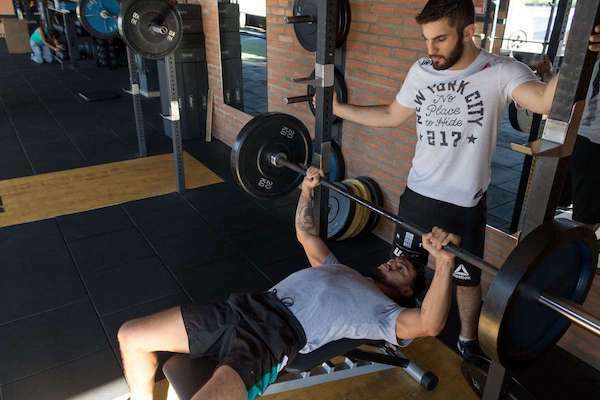Injuries at the Gym: A Comprehensive Exercise Guide
It’s true that the gym is a place where numerous orthopaedic injuries can occur. It is also true that most of these injuries are the result of improper technique, overexertion, and lack of conditioning, and can be avoided with the right knowledge and precautions. In this article, we will discuss common orthopedic injuries at the gym, identify specific exercises associated with each injury, and provide valuable tips to help you stay safe during your workout routine.
Table of contents
Shoulder Injuries
Pectoralis Major Rupture
- Exercise: Bench Press
- Injury: While performing heavy bench presses, sudden excessive strain on the pectoralis major muscle can cause a partial or complete tear. Common in bodybuilders. Pain, sudden pop sensation, palpable gap or obvious deformity in pec major contour.
- Prevention: Warm up adequately, use proper form and technique, gradually increase weights, and avoid overloading the chest muscles.
- Treatment: Rupture of the sternal part of the muscle is more common. Surgical treatment is usually required to repair the tear and eliminate the deformity. The tear is repaired through a small incision in the front of the armpit and the tendon is fixed in place with metal buttons.
Acromioclavicular (AC) Joint Sprain
- Exercise: Overhead Shoulder Press
- Injury: Incorrect form, excessive weight, or sudden jerking motions during overhead presses can strain or sprain the AC joint, leading to pain and instability. Distal clavicle osteolysis is common in weight lifters.
- Prevention: Maintain proper shoulder alignment, use lighter weights initially, gradually progress, and focus on strengthening the rotator cuff muscles.
- Treatment: almost always conservative. Surgical treatment reserved for acute injuries, or after non-operative treatment failure.


Knee Injuries
Meniscal tear
- Exercise: Deep Squats
- Injury: Performing deep squats with improper form, excessive weights, or sudden movements can place undue stress on the menisci, leading to tears.
- Prevention: Warm up adequately, use controlled motion, maintain proper knee alignment, and avoid excessive depth in squatting.
- Treatment: small degenerative tears can be treated conservatively, with physiotherapy. Larger tears in young individuals, tears that cause mechanical symptoms, or bucket handle tears, typically require surgery, with knee arthroscopy.
Patellar Tendοnitis
- Exercise: Jumping exercises (ie Box Jumps)
- Injury: Repetitive jumping exercises can strain the patellar tendon, causing inflammation and pain.
- Prevention: Gradually increase intensity, use proper landing techniques, wear supportive footwear, and incorporate exercises to strengthen the quadriceps and hamstrings.
- Treatment: activity modification, rest, NSAIDS, home exercise program.
Back Injuries
Lumbar Disc Herniation
- Exercise: Deadlifts
- Injury: Improper lifting technique, excessive weights, or sudden movements during deadlifts can lead to disc herniation in the lower back.
- Prevention: Engage core muscles, maintain a neutral spine, lift with proper form, use manageable weights, and incorporate exercises to strengthen the back and core muscles.
- Initial treatment is conservative. Consult an expert if you get pins & needles in the feet or toes.
Spondylolysis
- Exercise: Heavy Weighted Squats
- Injury: Repeatedly performing heavy weighted squats with poor technique or excessive loads can result in stress fractures in the pars interarticularis, causing spondylolysis.
- Prevention: Strengthen core and back muscles, maintain proper form, use suitable weights, and consider incorporating alternative exercises or variations.
- Treatment: this condition is common in adolescents. Treatment is conservative and requires abstinence from sports until symptoms disappear completely. Resistant cases may need bracing.
Ankle Injuries
Ankle Sprains
- Exercise: High-impact Cardio, ie jumping jacks (HIIT).
- Injury: High-impact exercises involving sudden movements or landing can cause ankle sprains, leading to ligament damage.
- Prevention: Warm up properly, wear supportive shoes, gradually increase intensity, and be mindful of landing mechanics and surfaces.
- Treatment: RICE & PT.
Achilles tendinopathy
- Exercise: Calf Raises
- Injury: Overuse or excessive loading during calf raises can strain the Achilles tendon, resulting in inflammation and pain.
- Prevention: Gradually increase intensity, use proper form and range of motion, incorporate stretching exercises, and avoid sudden increases in intensity.
- Treatment: activity modification & PT. If resistant, consider biological treatments (PRP).


Tips for a safe workout
- Learn the correct technique for performing each exercise and follow the instructions of an instructor to avoid unnecessary injuries at the gym.
- Start with lighter weights and gradually increase the weight during the workout.
- Activate and strengthen the muscles that support the joints involved in the exercises.
- Avoid excessive fatigue and overloading of muscles and joints.
- Consult a qualified Orthopedic Surgeon or Professional Trainer in case that you are experiencing pain.
By following these guidelines and incorporating injury prevention strategies, you can significantly reduce the risk of orthopedic injuries during your gym sessions. Stay proactive and consult with a healthcare professional if you experience persistent pain or discomfort. Your long-term orthopedic health is worth the investment of time and attention. Remember to prioritize safety and enjoy your fitness journey!
For more information or if you have concerns about an injury, we recommend that you contact a specialist Orthopedic Surgeon. Your safety and well-being is the highest priority.
Dr Panagopoulos is a specialized Orthopedic Surgeon with many years of experience abroad in Arthroscopic Surgery and Sports Injuries. Book an appointment today to get expert care for your problem.
FAQs - Frequently Asked Questions
What are some specific injuries for specific exercises?
Correct. Even though not always, some injuries present with a typical mechanism.
Bench press – > pec major rupture
Deep squats – > torn meniscus
HIIT – > ankle sprain
Deadlifts – > herniated disc
Find us
Book an appointment with us today
Injuries at the Gym: A Comprehensive Exercise Guide Read More »

